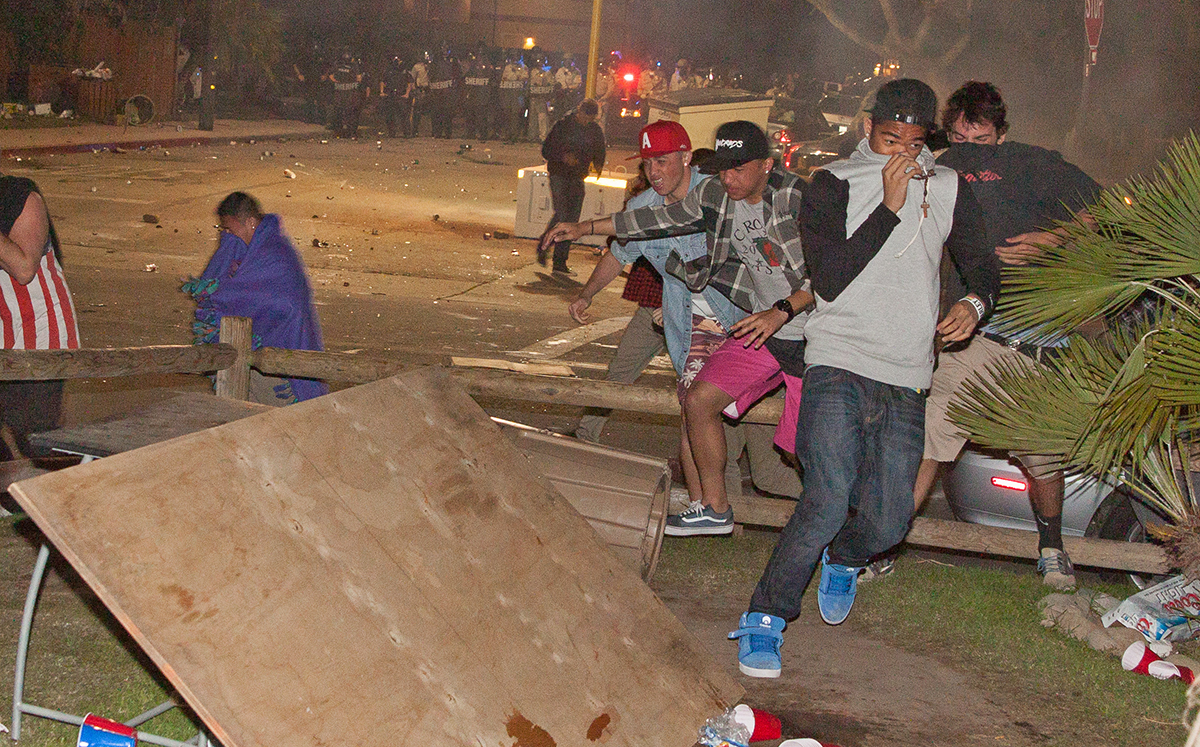Travis Fife: Settings like Deltopia need community, police cooperation

Participants of the annual Deltopia block party at UC Santa Barbara run from the police, who used riot tactics, including tear gas and rubber bullets, to disperse the crowd gathered on Del Playa Drive.
(Courtesy of Benjamin Pu/Daily Nexus)
By Travis Fife
April 10, 2014 12:00 a.m.
I walked into a bedroom trying to find a friend and instead only found the taste of tear gas. Five minutes earlier, a police officer had shot a can of tear gas into the bedroom where I was staying. Then came an hour of nothing but tear gas being launched into crowds of students and bottles crashing into police shields.
These are the memories I took away from my time at UC Santa Barbara’s annual Deltopia block party. You may have seen images, or at least heard the stories. Reports of violence against police officers, reports of students pelted with cans of tear gas and photos of fires in the streets have circulated in news outlets throughout the state.
Those reports overlook the underlying tension between police and the partygoers that made an event like this inevitable.
You could feel the hostility and resentment between the sides before the “riot” even happened. It was subtle – angry words to police trying to control the noise, a petty citation given simply to show who’s in control – but all day it was as if all the resentment felt by both sides was about to boil over.
In the days that have followed an event that left at least five officers injured and more than 100 people arrested, there has been a good amount of back and forth trying to pinpoint who is at fault for the utter chaos that ended what very well could be the last Deltopia.
But when both sides seem intent on demonstrating their power, when both sides spend the days leading up to the event preparing for some sort of conflict, don’t we always stand one misstep away from an actual battle?
Reports point to an L.A. teenager assaulting a police officer as the start of the real chaos, but from what I saw during the day, both sides seemed to be waiting for any chance, any excuse, to actualize a potential conflict.
In fact, numbers released by the Santa Barbara County Sheriff’s Office indicate only about 12 percent of those arrested said they attend UC Santa Barbara. Yet no measurement can capture the number of students making resentful comments or belting derogatory chants. This context was the ultimate – if not the immediate – catalyst for last weekend’s events.
This is why the question of blame is misplaced. Within the total chaos of last Saturday, there is no right or wrong, only embarrassment and injury for the people involved.
Instead of continuing a tired-out debate about the disconnect between youth and the establishment, we should reflect on what type of policing works for settings like Deltopia and Isla Vista.
The lessons learned can be applied to UCLA, where events of similar tone (if not scale) occur regularly. Most recently, a crowd of partiers in Westwood refused a police order to disperse after winter quarter’s Undie Run, resulting in the use of pepper balls against the partygoers. While the scale was smaller, the formula of drunk crowds and police in riot gear was the same and points to the need for a shift toward community-based policing.
Ultimately, law enforcement made it very clear last weekend that it wanted to deter any potential wrongdoing through strict punishments for breaking rules. But this approach skirts the necessity of cooperation between the community and police.
Events like Deltopia require a police effort that shows more respect from officers but also more respect from the community. This doesn’t mean more police officers in riot gear – it means leaders from both sides finding a middle ground with each other.
In addition to riot gear and noise ordinances, police can help set up medical stations down Del Playa Drive or distribute water bottles. They can offer amnesty for people who seek medical help for alcohol poisoning and forgo giving tickets for underage drinking to focus on scouting the crowd for those who might be in danger.
More importantly, police departments, both in Isla Vista and Westwood, can build trust with the community by presenting themselves at public events in less intimidating ways and by being more open with the college communities. These types of overtures can take many forms, but should be a priority for university police stations throughout the system.
This strategy isn’t mutually exclusive with a heavy police presence at large events, but these measures shift the image of the police from enforcers or enemies to a hardworking group of people trying to keep students safe.
Compare this to what actually happened – law enforcement installed five poles of cameras down Del Playa Drive before the event, right where the block party happened, and stoically patrolled every corner of the event. This isn’t putting the blame on law enforcement – students gave police every reason to be vigilant.
Similarly, instead of lamenting the “out of towners” as being responsible for the incident, UC Santa Barbara students and all in attendance can do a much better job holding each other accountable – maybe we should tell the guy breaking a windshield to stop, instead of waiting for an officer to do it.
Maybe instead of another militant response, students and law enforcement can come together to use occasions like Deltopia to cooperate. Maybe we’ll see safety measures instead of militarized police tactics, and Deltopia can be the peaceful and fun beach party that brought everyone to Isla Vista in the first place.
Hope to see you soon, Santa Barbara.

